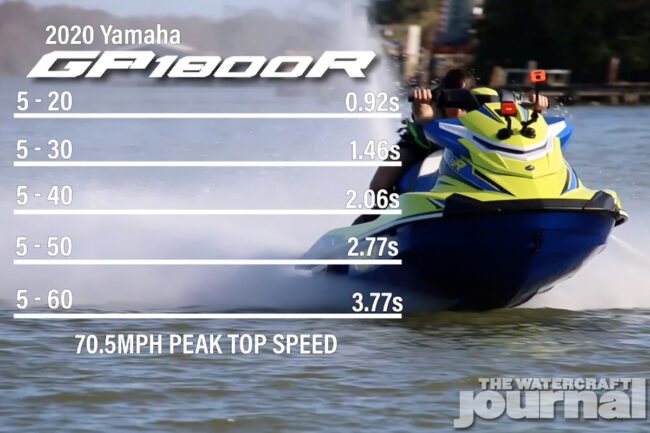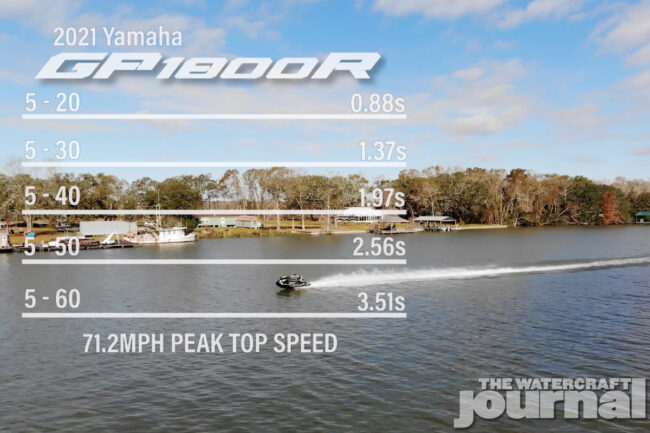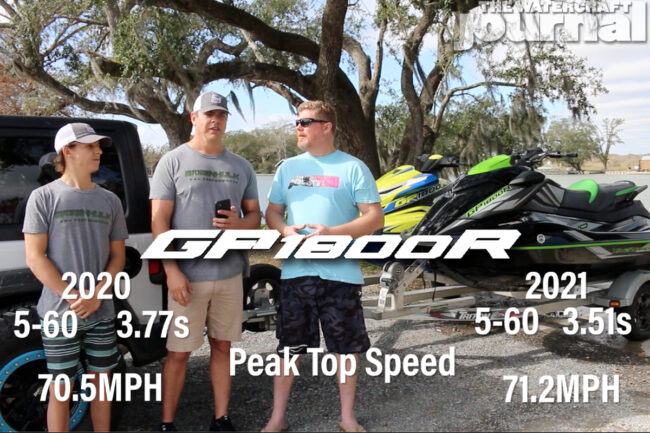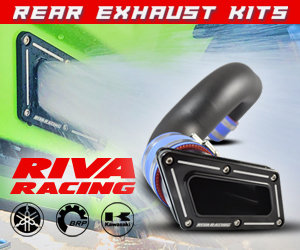2020 Yamaha Gp1800r Svho Top Speed


It's incredible what a few tweaks to an existing platform can make. In 2017, Yamaha introduced to the world the GP1800 – with the "R" designation coming out two years later in 2019. The change from "GP1800" to "GP1800R" gave the WaveRunner a redesigned a top-loader intake grate and race-designed ride plate for greater precision and predictability in rough water. These two changes alone radically improved initial acceleration as well as kept the pump loaded while making aggressive maneuvers and tracking through chop.
Out of the gate, this meant a difference of nearly half a second in 5-to-60 miles-per-hour times between the first 2017 models and the 2019. Yet in 2018, Sea-Doo came swinging with its redesigned RXT-X 300, and blew that number out of the water. Many will recall the shootout The Watercraft Journal conducted between a factory-stock 2018 Sea-Doo RXT-X 300 and a 2018 Yamaha GP1800, resulting in the RXT-X clicking off an 4.36 5-to-60mph time versus the Yamaha's 4.42.

At the time, we teamed up with Greenhulk.net's own Jerry Gaddis and established a few parameters that would render the most realistic (and repeatable) result. First, both vehicles would have their fuel tanks topped off. At 6-pounds a gallon, and it being two years before the RXT-X 300 would received Sea-Doo's enlarged 18.6-gallon fuel cell, many cried foul. Equally, since the GP1800 didn't come equipped with Launch Control (and the Sea-Doo did) we thought it fair not to use it. Again, folks cried foul.
Lastly, we used Jerry's Vbox Sport – one of the most trusted performance accelerometers available today – and opted (like we did before) to measure each ski individually from an idle speed of 5mph rather than trying to record a 0-to-60mph speed. Why? Because a true zero is impossible with an idling personal watercraft, even if it's in neutral. Equally, we would have the Vbox also record a peak top speed. All of this was done to conduct the most scientific and fair comparison possible, and we felt that we had done the very best.
At the close of summer last year, Yamaha rolled out the near entirely redesigned GP1800R SVHO for 2021. Retaining the same hull mold as that of 2017-and-up, the rest of the SVHO was revised in one way or another. Obviously, the most overt change was to the top deck, giving the GP1800R a curvier shape, a more contoured seat, Yamaha's full-color Connext digital dashboard, larger engine access, and a wholly re-engineered steering system with a 5-way adjustable tilt neck.
Below the removable top deck was the same Super Vortex High Output 1,812cc 4-cylinder four-stroke, but touting a new larger diameter supercharger clutch reducing slippage and wear. Equally, the inner hull liner redistributed the WaveRunner's weight by moving the 18.5-gallon fuel cell amidships by 3-inches, as well as lowering it deeper into the hull by over an inch. Finally, Yamaha re-machined the aluminum transom plate from 155mm to a true 160mm opening, removing the alternating taper that caused so much cavitation from a standstill.

Of course, when it comes to out-of-the-gate hookup, nothing beats a really aggressive top-loader intake grate, and that's exactly what Yamaha bolted to the 2021 GP. The new grate features a 20-percent larger inlet "chip" or ramp, ensuring more volume entering the pump at all speeds. When we at The Watercraft Journal first tested the 2021 GP1800R SVHO, we knew it pulled demonstrably harder than before…but how much more? For that, we decided to head back down to Louisiana and pay our friend Jerry a call.
Recently, Jerry handed the reigns to the Greenhulk Garage YouTube channel over to his son, Greg Gaddis, who as of recently, has been regularly testing a brand new 2021 GP1800R SVHO. Conversely, we had in our possession an impressively low-mileage 2020 GP1800R and thought it the perfect opportunity to conduct a showdown just like before. This time, this face-off would be less about brand loyalties and rather, measuring the improvements that Yamaha had made to the GP1800R platform over the years.

Per our established parameters, both WaveRunners would be ran with completely full tanks of fuel (18.5-gallons coming in at a total of 111-pounds). Equally, our conditions were nominal: 72-degrees outside with a faint 5-mph wind and zero current in the stretch of locked canal where we were testing. We tagged Greg to serve as our guinea pig, since he weighs 90-pounds less than either of us. And while it would prove less effective, we did conduct several passes on the 2021 using Launch Control, although Greg was able to fare better results manually.
Beginning with the 2020 Yamaha GP1800R, Greg was able to click off a respectable 3.77-second 5-to-60mph acceleration time, with a GPS-confirmed peak top speed of 70.5mph – that is, before the speed limiter pulled back on the throttle, dropping it back down to 68mph. In the video, the 2020 pulls hard, but almost immediately begins to cavitate, struggling to ingest and process the quantity of water necessary to maintain thrust. Worse, off as it reached peak speeds, the engine began "bouncing" off of rev limiter, causing the ski to surge.

Switching to the black-and-green 2021 GP1800R, the supercharged 1.8-liter launched hard and rocketed to an impressive 5-to-60mph of 3.51-seconds and again, a peak top speed of 71.2mph. From a crawl, the 2021 bites into the water hard and yanks Greg to 70-miles per hour almost without flinching. Again, attempts were made to best this time using the newly-added Launch Control feature, but Greg's toggling the electric trim manually fared better results.
After several passes and both engines sufficiently heat soaked, acceleration numbers were delayed but the placements did not. The 2020 pulled to 60mph in 3.96-seconds, while the 2021 sped to 60mph in 3.76-seconds (which was faster than the 2020 with the engine cool). Of course, the biggest revelation was how much better the 2021 GP1800R does compared to the original 2018 GP1800 we tested over two years earlier: 4.42-seconds versus 3.51-seconds is nearly nine-tenths of a second, or effectively, nine car lengths if you're talking drag racing.
In all, the advancements made to the GP1800R platform speak for themselves. We certainly we able to quantify the performance gains – at least in regards to initial acceleration – but there's still so much left to verify. Cornering prowess is certainly palpable to the keen rider; the WaveRunner's lean-in, and pull through the apex of a corner is exhilarating. Equally, the SVHO tracks so predictable through a variety of water conditions it's almost boring. We'll definitely be watching the professional racing circuit for those results, so until then, enjoy the video below:




2020 Yamaha Gp1800r Svho Top Speed
Source: https://watercraftjournal.com/video-2021-yamaha-gp1800r-svho-vs-2020-yamaha-gp1800r-svho-shootout/
